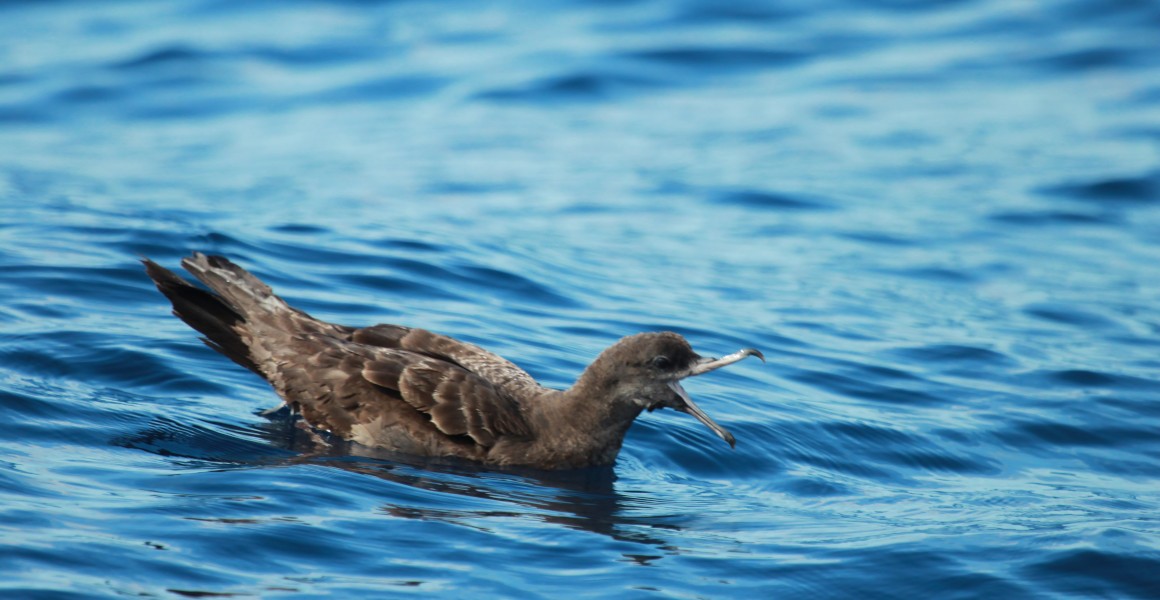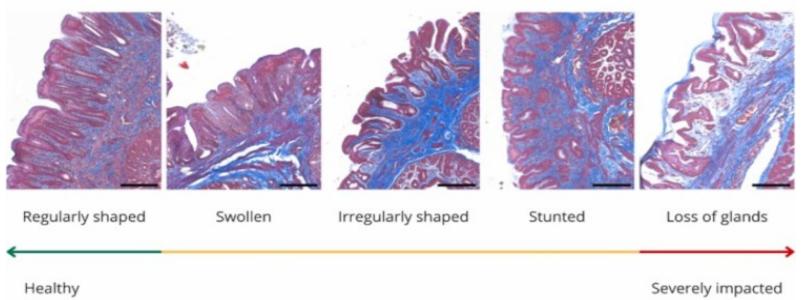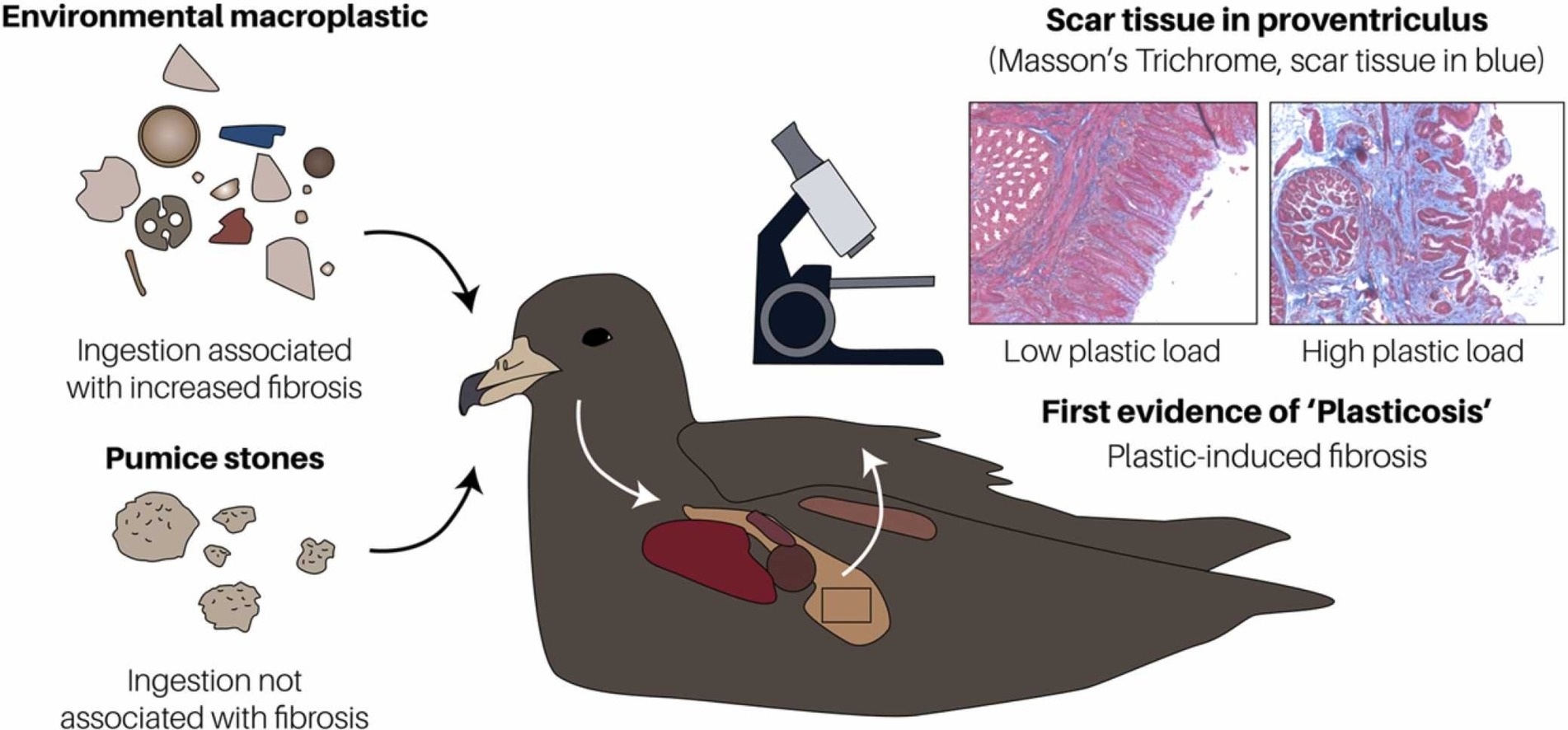博文
“塑化症”:一种由塑料引起的影响海鸟的新疾病
 精选
精选
||
“塑化症”:一种由塑料引起的影响海鸟的新疾病
诸平
Fig. 2 Plasticosis causes significant changes in the stomachs of birds suffering from it. Image © University of Tasmania, licensed under CC BY 4.0 via Journal of Hazardous Materials.
据英国自然历史博物馆(Natural History Museum)网站2023年3月3日首次发布的科学新闻,一种由塑料引起的影响海鸟的新疾病——“塑化症”或者“塑化病”(plasticosis)悄然而生('Plasticosis': a new disease caused by plastic that is affecting seabirds)。上述图1(Fig. 1)是肉足海鸥(Flesh-footed shearwaters)作为世界上受塑料污染最严重的物种之一。
塑料无处不在,而且已经变得如此普遍,以至于它正在影响动物和人类的健康。人体内血液中检出微塑料就是塑料污染的有力证据。现在的新研究表明,海鸟正在遭受一种由塑料引起的疾病——“塑化症”('plasticosis')的威胁。这种在海鸟中出现的一种新疾病,但它可能只是塑料污染的冰山一角。
“塑化症”不是由病毒或细菌引起的,而是由使消化道发炎的小塑料片引起的。随着时间的推移,持续的炎症会导致组织结疤和变形,对生长、消化和存活产生连锁反应。相关研究结果于2023年2月26日已经在《危险材料杂志》(Journal of Hazardous Materials)网站发表——Hayley S Charlton-Howard, Alexander L Bond, Jack Rivers-Auty, Jennifer L Lavers. 'Plasticosis': Characterising macro- and microplastic-associated fibrosis in seabird tissues. Journal of Hazardous Materials, 2023 Feb 26; 450: 131090. DOI: 10.1016/j.jhazmat.2023.131090
参与此项研究的有来自澳大利亚塔斯马尼亚州的海洋和南极研究所(Institute for Marine and Antarctic Studies, Battery Point, Tasmania, Australia)、英国自然历史博物馆(The Natural History Museum, Akeman Street, Tring, Hertfordshire, United Kingdom)、澳大利亚塔斯马尼亚大学(University of Tasmania, Liverpool Street, Hobart, Tasmania, Australia)以及澳大利亚新南威尔士州沃加沃加的查尔斯·斯特大学(Charles Sturt University, Wagga Wagga, New South Wales, Australia)的研究人员。
该研究的合著者,也是自然历史博物馆的首席策展人和负责鸟类策展人的亚历克斯·邦德博士(Dr Alex Bond)说:“虽然这些鸟的外表看起来很健康,但它们的内在并不好。这项研究是首次以这种方式研究胃组织,表明吞食塑料会对这些鸟类的消化系统造成严重损害。”
虽然到目前为止,塑料病只在一个物种中被发现,但塑料污染(plastic pollution)的规模意味着它可能更为普遍,甚至可能对人类健康产生影响。上述图2(Fig. 2)显示,塑化病会使患病鸟类的胃发生重大变化。
什么是塑化症?(What is plasticosis?)
增塑症是一种纤维化疾病。当身体的某个区域反复发炎并阻止伤口正常愈合时,这些情况是由于疤痕过多引起的。通常,受伤后会形成临时疤痕组织,有助于加强修复。但当炎症反复发生时,就会形成过多的疤痕组织,从而降低组织的柔韧性并导致其结构发生变化。
在塑化症的情况下,刺激是由塑料碎片深入胃组织引起的。科学家们发现它是他们在澳大利亚豪勋爵岛研究的一部分(their research on Lord Howe Island),他们在过去十年里一直在豪勋爵岛(Lord Howe Island)研究海鸟。
尽管该岛距离澳大利亚海岸 600 km,但该团队此前发现,生活在那里的肉足海鸥( flesh-footed shearwaters)是世界上受塑料污染最严重的鸟类(the most plastic contaminated birds in the world),因为它们将塑料碎片误认为食物后在海上食用。
在研究海鸥时,研究人员发现胃的第一个腔室——前胃(proventriculus)的疤痕很普遍,并在鸟类身上造成类似的伤口。它的一致性导致该团队将塑化症(plasticosis)描述为一种特定疾病。
虽然这个术语曾短暂地用于描述关节置换物中塑料的分解,但它的使用并不常见。结果,由于该名称与矽肺(silicosis)和石棉肺(asbestosis)等无机材料引起的其他纤维化疾病相似,该团队又恢复了该名称。
到目前为止,塑化症(plasticosis)只影响消化系统,但有迹象表明它可能会影响身体的其他部位,例如肺部。
十多年来,研究小组一直在调查豪勋爵岛的海鸟(图3)。
塑化症有何影响?(What are the impacts of plasticosis?)
由塑化症引起的疤痕影响胃腺的物理结构。随着塑料暴露的增加,组织逐渐变得更加肿胀,直到它开始分解。
亚历克斯·邦德解释道:“分泌消化化合物的管状腺体可能是塑化影响的最好例子。当塑料被消耗时,这些腺体会逐渐发育不良,直到它们最终在最高水平的暴露下完全失去组织结构。”
失去这些腺体会导致鸟类更容易受到感染和寄生虫的侵害,并影响它们吸收某些维生素的能力。疤痕还会导致胃部变硬、弹性降低,从而降低消化食物的效率。
对于幼鸟和小鸡来说,这尤其有害,因为它们的胃无法容纳那么多的食物。一些研究发现,多达90%的幼鸟至少含有一些父母喂给它们的塑料。在极端情况下,这会导致小鸡饿死(starve to death),因为它们的胃里塞满了它们无法消化的塑料。塑化症很可能也是影响塑料如何影响幼海鸥生长的因素之一。研究发现,翅膀的长度与它们体内塑料的数量有关,而塑料片的数量与鸟的整体重量有关。
虽然鸟类自然会吃掉其他无机物,例如浮石(pumice stones),但研究小组发现这不会造成疤痕。相反,浮石可能有助于将塑料分解成更小的碎片,从而造成进一步的损害。
“我们的研究团队之前研究过微塑料(microplastics)如何影响组织,”亚历克斯·邦德补充道,“我们在脾脏和肾脏等器官中发现了这些颗粒,它们与炎症、纤维化和结构完全丧失有关。”
目前,塑化症只存在于肉足海鸥中。但考虑到塑料污染的数量(the amount of plastic pollution),可以合理地假设其他物种也受到这种疾病的影响。
这是塑料影响全球动物健康的众多方式之一,包括血液化学变化(changes in blood chemistry)和荷尔蒙平衡的改变。
上述介绍,仅供参考。欲了解更多信息,敬请注意浏览原文或者相关报道。
• Extensive scar tissue formation was associated with plastic exposure in seabirds.
• Plastic significantly altered collagen prevalence within stomach tissue structures.
• Pathology was caused directly by plastic, rather than natural items, such as pumice.
• First record of plastic-related fibrosis in seabird stomach tissues.
• Evidence for a new plastic-induced fibrotic disease, ‘Plasticosis’.
As biota are increasingly exposed to plastic pollution, there is a need to closely examine the sub-lethal 'hidden' impacts of plastic ingestion. This emerging field of study has been limited to model species in controlled laboratory settings, with little data available for wild, free-living organisms. Highly impacted by plastic ingestion, Flesh-footed Shearwaters (Ardenna carneipes) are thus an apt species to examine these impacts in an environmentally relevant manner. A Masson's Trichrome stain was used to document any evidence of plastic-induced fibrosis, using collagen as a marker for scar tissue formation in the proventriculus (stomach) of 30 Flesh-footed Shearwater fledglings from Lord Howe Island, Australia. Plastic presence was highly associated with widespread scar tissue formation and extensive changes to, and even loss of, tissue structure within the mucosa and submucosa. Additionally, despite naturally occurring indigestible items, such as pumice, also being found in the gastrointestinal tract, this did not cause similar scarring. This highlights the unique pathological properties of plastics and raises concerns for other species impacted by plastic ingestion. Further, the extent and severity of fibrosis documented in this study gives support for a novel, plastic-induced fibrotic disease, which we define as 'Plasticosis'.
Graphical Abstract
https://m.sciencenet.cn/blog-212210-1379078.html
上一篇:用生物质回收稀土
下一篇:流落在外宝贝,何时才能回家?



